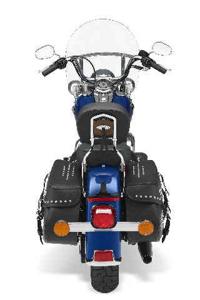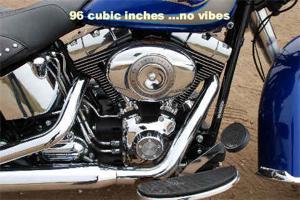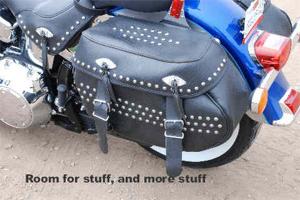The 2009 FLSTC Heritage Softail Classic is probably Harley-Davidson’s most traditional model. Facing the wind with its large headlight flanked by driving lights, its white sidewall tires mounted on wire wheels, and the ever so retro studded seat and saddlebags, you might think the Classic to be stalled somewhere in the latter half of last century. Styling-wise it is, but that’s intentional as the Heritage Classic has always had a strong following that doesn’t take well to having the model changed all that much.
The Heritage Classic is one of eight Softail models, nine if you add in the CVO Springer Softail. While based on the same chassis each of these models has its own distinct feel. With the Classic this feels starts with an upright seating position that would gladden the hearts of grade-school posture police. The low (25-inches), broad solo saddle pushes your fanny forward aided by a taller passenger seat, and the mini-ape bars hold your hands just below shoulder height. While this seating position suited my short stature (5’8″), taller riders might find it a bit cramped.
Nostalgic styling aside, the Classic is a modern touring motorcycle that will munch the miles with the best of the breed. Powered by the fuel-injected 96-cubic inch TC96B motor performance is a bit better than that of, for example, the FLHTCU Electra Glide Classic, despite having the same displacement. Most of this can be accounted for by the Softail’s more svelte self as it weights 100 pounds less. Maximum torque is five pounds less (87.9 ft./lbs. vs. 92.6 ft./lbs.), but it hits earlier at 2750 rpm, compared to the ‘Glide’s 3500 rpm. Given those two factors ?less weight, max torque at lower rpm? the Heritage feels more agile, more responsive than do the full Tourers. A five-gallon tank holds the fuel and you can expect gas mileage to be in the 40’s; play carefully and 50 mpg can be had.

The major mechanical difference between this Softail’s motor (actually, all the Softails) and that found in the full Touring models is that “B” suffix which indicates that the motor is balanced internally by two rotating weights which counter the inherent vibration in a V-Twin motor. The rest of the Harley lineup rubber-mounts their motors to quiet those vibes. Both systems are very effective at speed, but the “B” motors does a better job of settling things down at idle. Additionally, the non-B motors use rubber bushings to help isolate the vibes. This is a maintenance factor, though, as the rubber bushing do wear out, requiring replacement; not so with the “B” motors.
Since its inception in 1984, the Softail design has become the most copied of frame designs among the aftermarket custom builders. And with good reason, from an aesthetic standpoint; it gives a clean, uncomplicated “slammed” look to the bikes. Ride quality is compromised, however, due to the nature of the under-chassis shock absorber design. Prior to the introduction of the “B” motor in 2000 the combination of a less compliant suspension and a significant amount of vibration made the Softails an acquired taste. Currently, the “B” motor, and a much refined suspension, offer very acceptable ride quality. Just stay away from potholes and rough pavement.
Handling, of course, is a relative term with the ultimate goal always being compromised by, generally, style requirements. In the case of the Softail Classic this means you’ll be scraping the floorboards as soon as you get a bit aggressive in the turns. Interestingly, these pivoting boards don’t really upset the bike. Once you get used to the horrible grinding sounds you’ll find a cruiser that can actually be ridden relatively swiftly through the mountains.

Touring means carrying capacity and weather protection. Optioned out in a manner similar to an Electra Glide you can actually carry more on this Softail Classic than the Glide. Not more weight, but more stuff. While the weight load that an Electra Glide Classic can carry is 91 pounds more than that of the Softail (496 vs. 405), the Softail’s soft bags can accommodate more volume than the Glide’s hard bags due to their soft build. You can seemingly cram everything into the bags whereas the hard bags protest by refusing to latch once they’re overfilled.

All comes together nicely on the highway. Loaded up and rolling, you’ll find the Heritage Softail to be highly maneuverable, and a very easy motorcycle to ride.








Just bought a Softail classic because I’m impressed with the balanced motor and of course the look! My first Harley and can’t wait to RIDE!